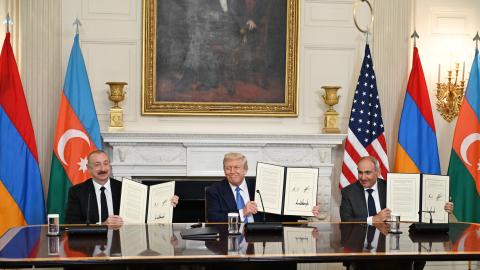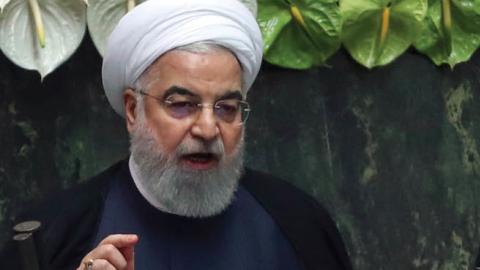The Iranian regime is shutting down the internet yet again this month—this time in response to the desperate protests in the Baluchistan and Sistan provinces. Tehran is methodically implementing a repressive playbook, imported at great expense from Beijing: first, label protesters as criminals; second, shut down the internet to prevent information from getting in or out; third, detain, torture and murder with impunity until the uprising is exhausted. But this time, the United States has the technology, resources and capacity to circumvent this oppression via satellite-provided internet, and give the Iranian opposition the ability to communicate freely. Deploying this capability would send the strongest possible message to the region and the world that America stands with those fighting for their freedom.
Also this month, perhaps not coincidentally, it was reported that the People's Republic of China is ramping up efforts to dominate the emerging frontier of satellite internet access. Presumably, the move reflects Beijing's concern that this new capability would undermine the regime's "great firewall" and put at risk the PRC's, and its clients', ability to isolate and fragment domestic resistance. Given our experience with Huawei and the 5G network, this should motivate the United States to exploit, not surrender, our technological edge to give the people of Iran a voice, but also to potentially offer it to others from Venezuela to Burma.
In June 2009, thousands of brave Iranians took to the streets to protest an obviously fraudulent presidential election. The strength and size of the protests took the Iranian regime by surprise, and the mullahs moved swiftly and brutally to suppress this "Green Revolution." Over the next decade under President Hassan Rouhani, who masterminded the suppression of the 1999 student revolt, Tehran, supported by Beijing, systematically built up a modern police state to monitor and break up any attempted uprising. When protests flared up again in late 2019, the regime was ready. Only, this time its tools were not only arrests, torture and execution—although these were aggressively employed—but also communications. In an unprecedented act of censorship, Tehran cut off the nation's internet for more than three days by shutting down the state-controlled National Information Network (NIN), effectively silencing protesters' attempts to organize and communicate.
From our positions on President Donald Trump's National Security Council Staff at the time, it was intensely frustrating not to have a ready-made response to the mullahs' suppression of the Iranian people's ability to receive and transmit information. The Trump administration was outspoken in support of the demonstrations and in condemnation of the regime's draconian tactics, but we could not restore the communications protesters desperately needed to sustain their efforts.
In the months after the protests were suppressed, the NSC worked to remedy this failure, and establish a secure and reliable means to bypass Tehran's Beijing-style censorship and firewall. While previous efforts had focused on circumventing the NIN as the sole source of bandwidth in Iran, we began to look to new capabilities to bypass it altogether.
We gained valuable insights from the catastrophic 2017 Atlantic hurricane season (the three most aggressive storms—Harvey, Irma and Maria—caused billions of dollars of damage and took thousands of lives). The recovery effort posed the challenge of providing communications access to remote or disrupted areas. Private enterprise and the federal government deployed experimental technologies to restore communications. Existing satellite constellations can now provide remote internet bandwidth virtually everywhere, and can be configured to work with commercially available remote very-small-aperture terminals or portable modems and antennae, which can employ Virtual Private Networks at encryption levels that will protect users and allow them to access the internet completely independent of Tehran's NIN.
This project to harness this new capability and provide secure and reliable internet access to the Iranian people, which comes at a relatively modest cost, was initiated at the end of the Trump administration. The new administration should aggressively pursue it in light of the most recent uprising in Iran, as well as the threat from China to circumvent dissent. The project has broad, bipartisan congressional support; in 2019 the Senate Appropriations Subcommittee on State, Foreign Operations and Related Programs increased the funding for Global Internet Programs in its appropriations bill for the 2020 fiscal year to $70.5 million, an increase of $10 million from the previous fiscal year. These and other resources can be expeditiously reprogrammed to restore communications to the oppressed protesters in Baluchistan and Sistan.
Offering a voice to the Iranian people would hardly be an act of aggression—it would simply be a demonstration of America's commitment to the basic principle of the freedom of speech, a cornerstone of our Bill of Rights. That freedom should be a signature export for us, just as despotic censorship is for the PRC. Furthermore, the people of Iran will head to the polls this June for another presidential election. In the event there is a revival of the Green Revolution, getting this capability into place now could both circumvent and expose any attempt by the Iranian regime and their Chinese patrons to revert to their well-worn playbook of repression and brutality.
Read in Newsweek


















